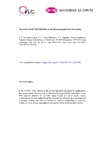Mostrar o rexistro simple do ítem
Low-Complexity Distance-Based Scheduling for Multi-User XL-MIMO Systems
| dc.contributor.author | González-Coma, José P. | |
| dc.contributor.author | Lopez-Martinez, F.J. | |
| dc.contributor.author | Castedo, Luis | |
| dc.date.accessioned | 2024-01-19T09:12:26Z | |
| dc.date.available | 2024-01-19T09:12:26Z | |
| dc.date.issued | 2021-11 | |
| dc.identifier.citation | J. P. Gonzalez-Coma, F. J. Lopez-Martinez, y L. Castedo, «Low-Complexity Distance-Based Scheduling for Multi-User XL-MIMO Systems», IEEE Wireless Commun. Lett., vol. 10, n.o 11, pp. 2407-2411, nov. 2021, doi: 10.1109/LWC.2021.3101940. | es_ES |
| dc.identifier.issn | 2162-2337 | |
| dc.identifier.issn | 2162-2345 | |
| dc.identifier.uri | http://hdl.handle.net/2183/35002 | |
| dc.description | © 2021 IEEE. This version of the article has been accepted for publication, after peer review. Personal use of this material is permitted. Permission from IEEE must be obtained for all other uses, in any current or future media, including reprinting/republishing this material for advertising or promotional purposes, creating new collective works, for resale or redistribution to servers or lists, or reuse of any copyrighted component of this work in other works. The Version of Record is available online at: https://doi.org/10.1109//LWC.2021.3101940 | es_ES |
| dc.description.abstract | [Abstract]: We introduce Distance-Based Scheduling (DBS), a new technique for user selection in downlink multi-user communications with extra-large (XL) antenna arrays. DBS categorizes users according to their equivalent distance to the antenna array. Such categorization effectively accounts for inter-user interference while largely reducing the computational burden. Results show that ( i ) DBS achieves the same performance as the reference zero-forcing beamforming scheme with a lower complexity; ( ii ) a simplified version of DBS achieves a similar performance when realistic spherical-wavefront (SW) propagation features are considered; ( iii ) SW propagation brings additional degrees of freedom, which allows for increasing the number of served users. | es_ES |
| dc.description.sponsorship | This work was funded by the Xunta de Galicia (ED431G2019/01), the Agencia Estatal de Investigación of Spain (TEC2016-75067-C4-1-R, PID2020-118139RB-I00), ERDF funds of the EU (AEI/FEDER, UE), the Junta de Andalucia and the European Fund for Regional Development FEDER (project P18-RT-3175) | |
| dc.language.iso | eng | es_ES |
| dc.publisher | IEEE | es_ES |
| dc.relation | info:eu-repo/grantAgreement/AEI/Plan Estatal de Investigación Científica y Técnica y de Innovación 2013-2016/TEC2016-75067-C4-1-R/ES/CODIFICACIÓN Y PROCESADO DE SEÑALES PARA REDES EMERGENTES DE COMUNICACIÓN Y DE SENSORES INALÁMBRICAS | |
| dc.relation.uri | https://doi.org/10.1109/LWC.2021.3101940 | es_ES |
| dc.rights | Copyright © 2021, IEEE | es_ES |
| dc.subject | Antenna arrays | es_ES |
| dc.subject | Massive MIMO | es_ES |
| dc.subject | Near-field | es_ES |
| dc.subject | Precoding | es_ES |
| dc.subject | XL-MIMO | es_ES |
| dc.title | Low-Complexity Distance-Based Scheduling for Multi-User XL-MIMO Systems | es_ES |
| dc.type | info:eu-repo/semantics/article | es_ES |
| dc.rights.access | info:eu-repo/semantics/openAccess | es_ES |
| UDC.journalTitle | IEEE Wireless Communications Letters | es_ES |
| UDC.volume | 10 | es_ES |
| UDC.issue | 11 | es_ES |
| UDC.startPage | 2407 | es_ES |
| UDC.endPage | 2411 | es_ES |
Ficheiros no ítem
Este ítem aparece na(s) seguinte(s) colección(s)
-
GI-GTEC - Artigos [186]






